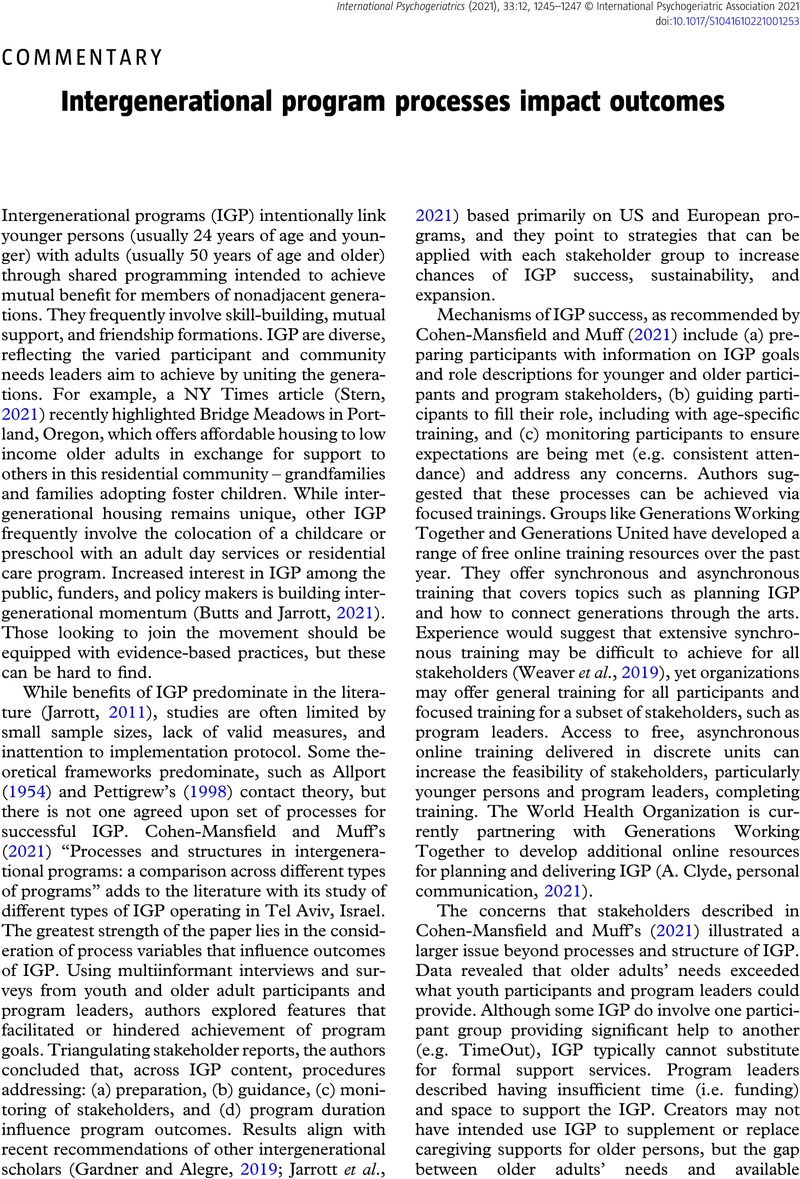No CrossRef data available.
Article contents
Intergenerational program processes impact outcomes
Published online by Cambridge University Press: 24 September 2021
Abstract
An abstract is not available for this content so a preview has been provided. Please use the Get access link above for information on how to access this content.

- Type
- Commentary
- Information
- International Psychogeriatrics , Volume 33 , Special Issue 12: Issue Theme: Social Engagement and Mental Health , December 2021 , pp. 1245 - 1247
- Copyright
- © International Psychogeriatric Association 2021
References
Breck, B. M., Dennis, C. B. and Leedahl, S. N. (2018). Implementing reverse mentoring to address social isolation among older adults. Journal of Gerontological Social Work, 61, 513–525. DOI 10.1080/01634372.2018.1448030.CrossRefGoogle ScholarPubMed
Butts, D. M. and Jarrott, S. E. (2021). The power of proximity: co-locating childcare and eldercare programs. In: Greenberg, M. and Stamp, T. (Eds.), Stanford Social Innovation Review. Available at: https://ssir.org/articles/entry/the_power_of_proximity_co_locating_childcare_and_eldercare_programs
Google Scholar
Cohen-Mansfield, J. and Muff, A. (2021). Processes and structures in intergenerational programs: a comparison across different types of programs. International Psychogeriatrics, 33, 1297–1308. doi: 10.1017/S1041610221000922.CrossRefGoogle ScholarPubMed
Gardner, P. and Alegre, R. (2019). "Just like us”: increasing awareness, prompting action and combating ageism through a critical intergenerational service learning project. Educational Gerontology, 45, 146–158. DOI 10.1080/03601277.2019.1584976.CrossRefGoogle Scholar
Jarrott, S. E. (2011). Where have we been and where are we going? Content analysis of evaluation research of intergenerational programs. Journal of Intergenerational Relationships, 9, 37–52 DOI 10.1080/15350770.2011.544594.CrossRefGoogle Scholar
Jarrott, S. E., Scrivano, R. M., Park, C. and Mendoza, A. N. 2021. Implementation of evidence-based practices in intergenerational programming: a scoping review. Research on Aging, 43(7–8), 283–293. DOI 10.1177/0164027521996191.CrossRefGoogle ScholarPubMed
Norouzi, N., Jarrott, S. E. and Chaudhury, H. (2019). Designing intergenerational space through a human-development lens. Journal of Architectural and Planning Research, 36, 35–51.Google Scholar
Pettigrew, T. F. (1998). Intergroup contact theory. Annual Review of Psychology, 49, 65–85. DOI 10.1146/annurev.psych.49.1.65.CrossRefGoogle ScholarPubMed
Seefeldt, C. (1987). The effects of preschoolers' visits to a nursing home. The Gerontologist, 27, 228–232. DOI 10.1093/geront/27.2.228.CrossRefGoogle ScholarPubMed
Stern, C. (August 22, 2021). Grandfamily housing caters to older Americans raising children. The New York Times, BU, 4. Available at: https://www.nytimes.com/2021/08/19/business/retirement-grandparents-raising-children.html?surface=most-popular&fellback=false&req_id=982157325&algo=bandit-all-surfaces-uh-nclicks-alpha-01&variant=1_bandit-all-surfaces-uh-nclicks-alpha-01&pool=pool/91fcf81c-4fb0-49ff-bd57-a24647c85ea1&imp_id=933122260&action=click&module=Popular%20in%20The%20Times&pgtype=Homepage.Google Scholar
Weaver, R. H., Naar, J. J. and Jarrott, S. E. (2019). Using contact theory to assess staff perspectives on training initiatives of an intergenerational programming intervention. The Gerontologist, 59, 270–279. DOI 10.1093/geront/gnx194.CrossRefGoogle ScholarPubMed




